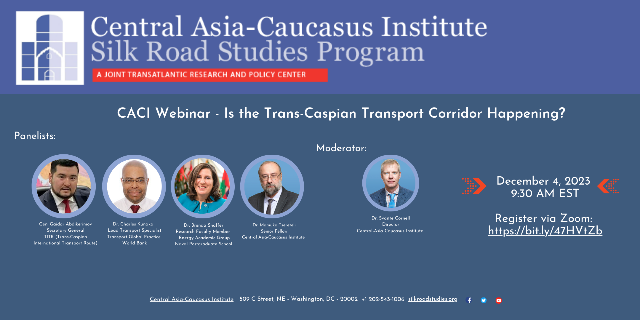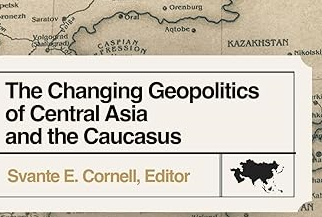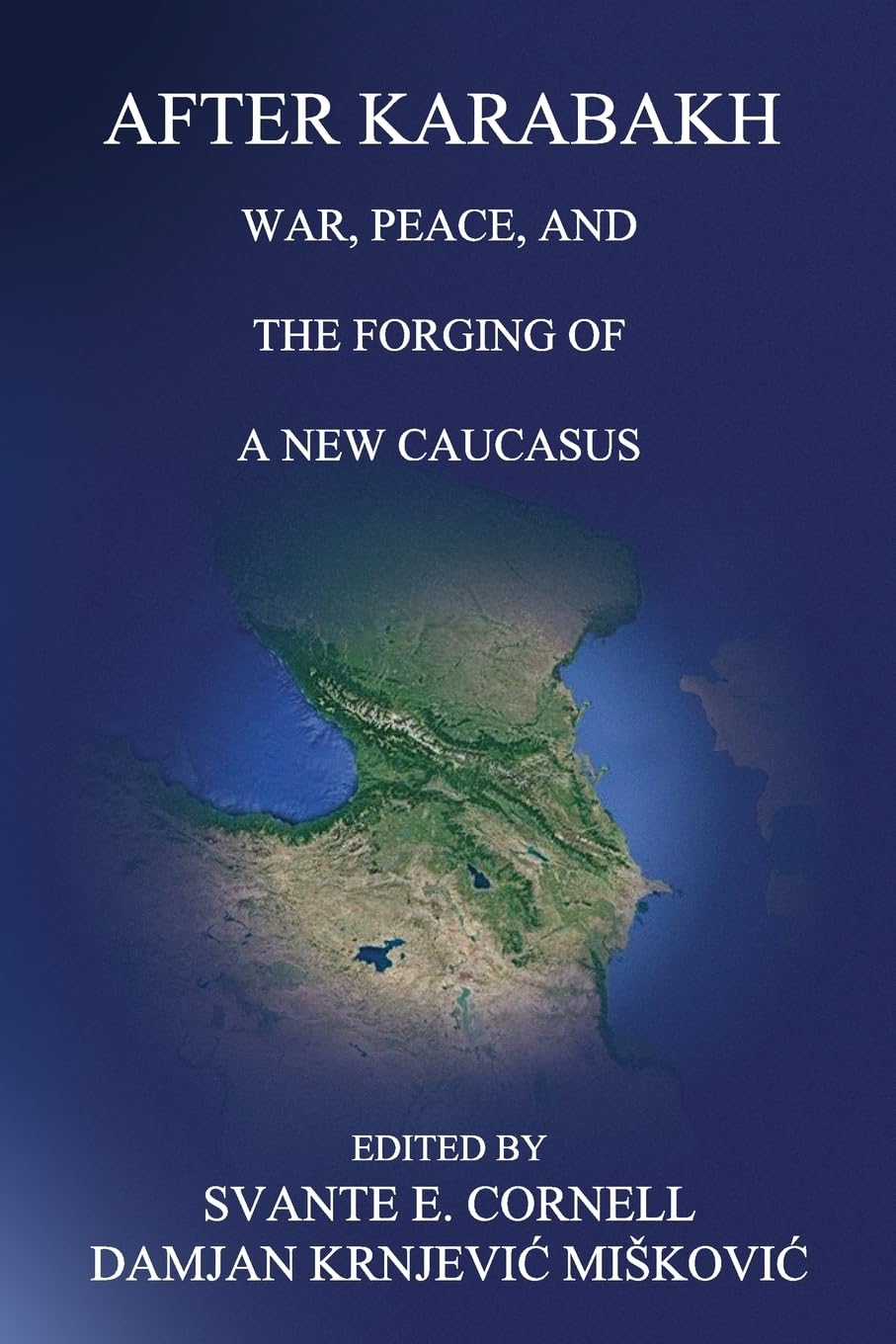After Karabakh: War, Peace, and the Forging of a New Caucasus
by Svante E. Cornell and Damjan Krnjević Mišković
AFPC Press/Armin Lear, 2025
Link to Amazon and Kindle Edition
The outcome of the Second Karabakh War is a watershed event in the modern history of Eurasia. It represents the moment of conception of a new South Caucasus, the only part of the world that borders on Russia, Turkey, and Iran. Unsurprisingly, external powers like the U.S., China, the EU, India, and the GCC states are all taking greater interest in its future.
Written for scholars and designed for classroom use, AFTER KARABAKH: War, Peace, and the Forging of a New Caucasus is the go- to book for anyone trying to make sense of the geopolitics of this often misunderstood conflict. As the editors argue in their Introduction, the end of the conflict over Karabakh “will serve as a catalyst for the instauration of a much anticipated peace dividend centered on optimizing the region’s strategic connectivity potential.”
As Michael Doran writes in the Foreword, AFTER KARABAKH “performs a great service to students of international politics. We now have in one volume a set of comprehensive analyses of the main dimensions of the Second Karabakh War. By producing sharp, judicious, and readable accounts, the authors, who are all internationally recognized experts in their fields, have ensured that this volume will become the standard account of the conflict.”
Editors
Svante E. Cornell is Research Director of the American Foreign Policy Council’s Central Asia-Caucasus Institute and a co-founder of the Institute for Security and Development Policy (ISDP)
Damjan Krnjević Mišković is Professor of Practice at ADA University, where he serves concurrently as Director for Policy Research, Analysis, and Publications at the Institute for Development and Diplomacy and Co-Editor of Baku Dialogues.
Table of Contents
Introduction: The Second Karabakh War and a New Caucasus: The Regional Peace Dividend Playing Out at the Card Table; Damjan Krnjević Mišković and Svante E. Cornell
The Geopolitics of the Caucasus and the Road to War; Svante E. Cornell
Perfect Timing and Statecraft: On the Onset of the Second Karabakh War; Damjan Krnjević Mišković
The Foreign and Security Policies of Armenia and Azerbaijan, 1994-2020; Robert M. Cutler
The Evolving Role of the West in the Armenia-Azerbaijan Conflict; Svante E. Cornell
Sitting on Two Chairs: Russia's Pragmatic, Transactional Approach to the Karabakh Question; Nikolas K. Gvosdev
Gradually, then Suddenly: The Evolution of Tiirkiye's Role in the Armenia-Azerbaijan Conflict; Michael A. Reynolds
Iran's Role in the Armenia-Azerbaijan Conflict; Brenda Shaffer
Armenia's Pashinyan Conundrum: Implications of the Second Karabakh War; Onnik James Krikorian
No More War, Not Yet Peace: On the Second Karabakh War and Its Aftermath; Fariz Ismailzade
Military Lessons from the Second Karabakh War; Niklas Nilsson
The Geopolitical Causes and Consequences of the Second Karabakh War: Armenian Tragedy, Azerbaijani Vindication, and Prospects for Peace; Damjan Krnjević Mišković
Has the West "Lost" Azerbaijan?
By Robert M. Cutler
Azerbaijani President Ilham Aliyev’s April 2025 state visit to China, culminating in the signing of a Comprehensive Strategic Partnership, marks a significant elevation in bilateral relations. The agreement is more than a symbolic gesture: it reflects a strategic convergence across infrastructure, energy, and digital development. It also signals a re-balancing of power in the South Caucasus in response to Western inertia. As China consolidates its position, the question is no longer whether the West leads but whether it has already surrendered the initiative.
BACKGROUND: The Second Karabakh War of 2020 abruptly exposed the obsolescence of entrenched diplomatic frameworks in the South Caucasus, most notably the OSCE Minsk Group. The November 2020 Trilateral Statement that ended the fighting, brokered under Russia’s aegis, signified an incipient restructuring of regional dynamics. Russia positioned itself as the nominal guarantor of stability, installing a contingent of so-called peacekeepers on Azerbaijani territory. Yet this maneuver, driven by residual influence and opportunistic calculus, underscored Moscow’s determination to preserve a semblance of relevance amid shifting fault lines.
While Russia acted following long-established and well-defined interests, the U.S. and the EU hesitated. The initiatives introduced by Western actors, preoccupied with internal crises and other entanglements, lacked coherence, confidence, and strategic vision. The mediation efforts were fragmented and the summits were ad hoc. As a result, the promising diplomatic overtures failed to generate substantive traction. The reactive nature of Western engagement post-2020 contrasts starkly with the proactive moves of regional and other stakeholders having more immediate stakes in the evolving South Caucasus order.
Turkey’s deepening military partnership with Azerbaijan, formalized through the Shusha Declaration of 2021, epitomized pragmatic alignment. Kazakhstan, seizing the moment, accelerated its integration into the emergent Middle Corridor, bolstering East-West logistics networks through the Caspian basin. Concurrently, Gulf states capitalized on Azerbaijan’s post-war stabilization by channeling substantial investments into renewable energy infrastructure, particularly solar and wind projects in the liberated territories. These tangible gestures did not just reflect geoeconomic calculations but represented a recognition of the region’s latent economic potential.
In this context, China modified its traditionally cautious posture in the South Caucasus. Historically deferential to Russia’s informal sphere of influence, Beijing began to reassess the region’s strategic significance following the full-scale Russian invasion of Ukraine in February 2022. The resulting destabilization of Eurasian corridors, compounded by Western sanctions and the geopolitical weaponization of supply chains, propelled the South Caucasus from peripheral concern to a central axis in China’s connectivity strategy. This shift was not reflexive or opportunistic. Rather, it reflected China’s measured strategic assessment of the structural transformations in the architecture of Eurasian trade.
By 2022, the foundations for a deepening Sino-Azerbaijani partnership had been firmly established. The signing of a joint declaration on strategic partnership at the Shanghai Cooperation Organization summit in July 2024 signaled a decisive commitment to broaden bilateral economic ties. The two countries’ trade in 2024 was over 20 percent above its 2023 level, reaching nearly US$ 3.74 billion. Chinese enterprises expanded into sectors previously peripheral to their Eurasian ambitions: telecommunications, green energy, and transport logistics. President Ilham Aliyev’s state visit to Beijing in April 2025 did not initiate this trend but rather consolidated it. The Comprehensive Strategic Partnership (CSP) agreement was the logical culmination of sustained and deliberate moves that anchored Azerbaijan’s strategic realignment toward the East.
IMPLICATIONS: The realignment is not mere economic opportunism. Rather, it signals a deeper geopolitical evolution driven by the inadequacy of Western engagement and the region’s preparedness to respond to actors willing to match rhetoric with decisive action. The failure of Western policy is not just about inattentiveness, but also about an inability to grasp the interplay between regional agency, emerging connectivity frameworks, and the geopolitical vacuum created by Russia’s shifting posture. In this unfolding dynamic, Azerbaijan has moved beyond waiting for Western recognition or support. It has instead begun to assert its own role within a rapidly realigning Eurasian order.
For China, Azerbaijan serves as a gateway not only to Europe through the Middle Corridor but also toward the Middle East, reinforcing China’s broader trade architecture and strategic depth in the region. The CSP is not a symbolic gesture. Its scope is broad and consequential, encompassing coordinated industrial development, infrastructure harmonization, technology transfer, and streamlined customs protocols. These measures are underpinned by capital investments and long-term industrial partnerships.
For Azerbaijan, the CSP consolidates a deliberate move to attenuate traditional dependencies on Western and Russian interlocutors. It embodies Azerbaijan’s long-articulated aspirations for economic diversification, substantiated now by tangible capital flows and operational partnerships. The CSP’s provisions span petrochemicals, metallurgy, mechanical engineering, and renewables. Agreements on aerospace and intellectual property signal a strategic depth, eschewing transactional engagement in favor of embedded, systemic collaboration.
The transport dimension alone is reshaping regional dynamics. The Middle Corridor, stretching from China through Kazakhstan, the Caspian basin, and into the South Caucasus and Europe, has demonstrated rapid growth. While still smaller in scale than northern routes traversing Russia, its year-on-year expansion has been notable. A trilateral joint venture among Kazakhstan, Azerbaijan, and Georgia’s rail operators is actively synchronizing digital customs tracking and reducing delivery times to enhance competitiveness.
The Port of Alat, central to Azerbaijan’s maritime logistics, has already undergone substantial upgrades. Cross-border road transport agreements and operational protocols with China, concluded in 2024 and 2025, are streamlining east–west trade flows. China’s formal recognition of Azerbaijan as a "central transit node" underscores the strategic weight of this integration.
The significance of the CSP extends beyond ports and pipelines. Digital infrastructure has emerged as a foundational pillar. Huawei and ZTE, longstanding presences in the region, have solidified their positions through new agreements establishing joint research centers, expanding data infrastructure, and modernizing e-government frameworks. These initiatives are embedding Chinese technological standards into the South Caucasus and positioning Baku as a nascent digital hub.
Energy collaboration has similarly accelerated. China’s Universal Energy is backing the Gobustan solar project, with further discussions ongoing over potential wind energy developments along the Caspian coast. These initiatives are paralleled by an expansion of Chinese soft power, from Confucius Institutes to cultural exchanges and educational programs.
Azerbaijan has not “abandoned” the West. The reality is starker: the West has failed to keep pace with Azerbaijan’s evolving strategic calculus. President Aliyev’s visit to Beijing and the CSP with China are less an embrace of Beijing than a commentary on the chronic insufficiencies of Western engagement. For years, Baku signaled openness to deeper commercial ties, infrastructure investments, and a balanced diplomatic posture. What it often received were half-measures, symbolic gestures, and ideological critiques.
The waning of Western diplomatic leverage in the South Caucasus is not a sudden anomaly. It is the cumulative outcome of incremental miscalculations, fragmentary approaches, and the persistent failure to integrate regional realities into a coherent strategic vision. The 2020 Second Karabakh War marked a decisive inflection point. Azerbaijan’s reintegration of its formerly occupied territories exposed the impotence of frameworks long regarded as the bedrock of resolution efforts. The abrupt reassertion of Azerbaijani territorial sovereignty in 2020, and its completion in 2023, underscored the extent to which Western actors had become disconnected from the region’s evolving dynamics.
Europe’s Global Gateway initiative, though nominally prioritizing the Middle Corridor, remains hesitant and underfunded. The U.S., preoccupied with broader geopolitical contests, has failed to sustain a coherent South Caucasus policy. When attention does surface, it is often filtered through domestic advocacy agendas misaligned with both regional stability and U.S. strategic interests. Thus, under the influence of domestic lobbies, two of the Biden administration’s last acts were to decline to waive Section 907 of the Freedom Support Act, which bans direct assistance to the Azerbaijani government, and to sign a bilateral strategic partnership charter with the Armenian government.
CONCLUSIONS: The South Caucasus has shifted from constituting a peripheral zone to a strategic nexus. Capital and influence from East Asia, Central Asia, and the Middle East are converging upon the region. Turkey, Kazakhstan, and the Gulf states have become active participants in this evolving matrix. Azerbaijan, far from merely serving as a bridge, has assumed the role of architect and builder of new routes. Aliyev’s visit to Beijing is emblematic of this shift. Baku no longer waits for external recognition; it engineers its own relevance.
The West must recognize this not as a defection, but as an adaptation to opportunity over nostalgia. The coming months will be decisive. If the West wishes to remain a meaningful player, it must replace rhetorical overtures with substantive commitments: joint infrastructure ventures, credible support for energy transition, and diplomatic engagement rooted in regional realities rather than encumbered by historical preoccupations.
Azerbaijan’s choice is not between China and the West, but between agency and irrelevance. It has already chosen. The question now is whether the West retains both the capacity—and the will—to respond.
AUTHOR’S BIO: Robert M. Cutler is Director and Senior Fellow, Energy Security Program, NATO Association of Canada. He was for many years a Senior Research Fellow with the Institute of European, Russian and Eurasian Studies, Carleton University.
Register for the 2024 CAMCA Conference - June 12-13 - Bishkek, Kyrgyzstan
Register for the annual Central Asia - Mongolia - Caucasus - Afghansitan (CAMCA) Regional Forum scheduled for June 12-13 in Bishkek, Kyrgyzstan. The CAMCA Regional Forum is a non-political and non-partisan Forum established to promote region-wide discussions on means of advancing economic growth and development in the 10 countries of the region: Afghanistan, Armenia, Azerbaijan, Georgia, Kazakhstan, Kyrgyzstan, Mongolia, Tajikistan, Turkmenistan and Uzbekistan. It promotes this goal by fostering dialogue and interaction among rising young leaders from all sectors in the 10 countries of the region, as well as with international leaders and stakeholders. The Forum organizers - the CAMCA Network, Central Asia-Caucasus Institute and the Rumsfeld Foundation - believe that expanded communication and collaboration among talented professionals from a range of fields can significantly contribute to economic, political and social development on both a national and regional basis.
The Forum is a premier opportunity to engage with prominent influencers and leaders in the CAMCA region and to gain firsthand insights on the region’s pulse and latest developments. The Forum’s non-political and non-partisan mission facilitates an environment for open conversation aimed toward the prosperity of the region and its people. The Forum was established as one of the first and only platforms to bring together representatives of the 10 CAMCA countries, spanning from the South Caucasus to Mongolia, to discuss emerging opportunities for regional cooperation and integration. Due to the diverse and impressive pool of participants, the Forum essentially serves as a ‘one-stop shop’ for professionals of all sectors who are interested in regional cooperation and partnerships, as well as for outside nations, businesses and organizations that have an interest in engaging with the region.
Click here for more information and to register.
Watch the 12/4 CACI Webinar - Is the Trans-Caspian Transport Corridor Happening?

The vision of a transportation corridor linking Europe to Asia through the Caucasus and Central Asia was conceived almost a soon as the USSR collapsed. However, in spite of progress, major infrastructure remains to be built for this corridor to truly matter. In the past year, geopolitical developments have spurred the states in Central Asia and the Caucasus into action. Major regional states have linked arms like never before to speed this corridor into realization. To discuss the corridor, its challenges and its implications, the Central Asia-Caucasus Institute invites you to the following web-based Forum.
PANELISTS:
- Gen. Gaidar Abdikerimov, Secretary General, TITR (Trans-Caspian International Transport Route)
- Dr. Charles Kunaka, Lead Transport Specialist, Transport Global Practice, World Bank
- Dr. Brenda Shaffer, Research Faculty Member, Energy Academic Group, Naval Postgraduate School
- Dr. Mamuka Tsereteli, Senior Fellow, CACI
MODERATOR:
- Dr. Svante Cornell, Director, Central Asia-Caucasus Institute
The Changing Geopolitics of Central Asia and the Caucasus





